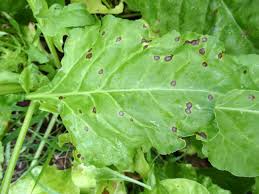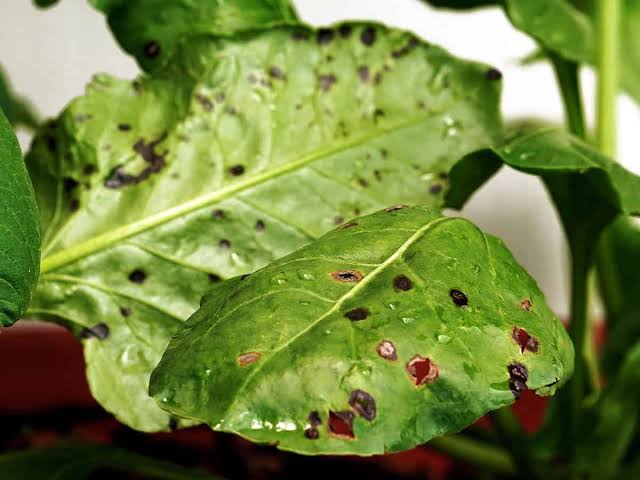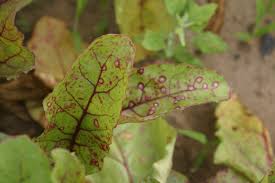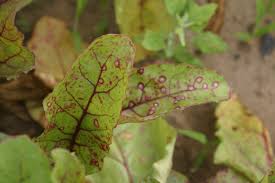Cercospora Leaf Spot Scientifically known as Cercospora spp. is a plant disease caused by various species within the genus Cercospora. These microscopic fungi primarily target the leaves of plants, leading to characteristic leaf spots that can affect a wide range of crops, including vegetables, fruits, and ornamental plants.
The presence of Cercospora leaf spot is often identified by the appearance of small, round lesions on the leaves. These spots typically have a tan to grayish center with a darker border, creating a distinctive appearance. As the infection progresses, the spots may enlarge and coalesce, resulting in extensive damage to the foliage.
The lifecycle of Cercospora spp. involves the production of spores, which are spread through various means such as wind, rain, or agricultural practices. Warm and humid conditions favor the development and spread of the disease, making it more prevalent in certain climates and seasons.
One of the key challenges posed by Cercospora leaf spot is its potential to reduce the photosynthetic capacity of affected plants. As the disease progresses, the compromised leaves may experience premature senescence, impacting the overall health and productivity of the plant. This can have significant implications for crop yield and quality.
Management of Cercospora leaf spot involves a combination of cultural, chemical, and biological control methods. Crop rotation, proper sanitation, and the use of disease-resistant plant varieties are essential components of an integrated approach to prevent and manage the disease. Additionally, fungicides may be employed to suppress the spread of Cercospora spp., especially during periods of high disease pressure.
Despite the challenges posed by Cercospora leaf spot, ongoing research and advancements in agricultural practices continue to contribute to the development of effective strategies for disease management. Farmers and horticulturists play a crucial role in implementing these practices to mitigate the impact of Cercospora leaf spot and ensure the health and vitality of their crops.
In addition, Cercospora leaf spot, caused by various species within the Cercospora genus, is a common and potentially damaging plant disease. Recognizing the symptoms, understanding the disease cycle, and implementing integrated management strategies are vital for minimizing the impact of Cercospora leaf spot on agricultural and horticultural crops.
Read Also: White Mold: Description, Damages Caused, Control and Preventive Measures
Plants Affected by Cercospora Leaf Spot (Cercospora spp.)

Cercospora leaf spot can affect a wide range of plants, including various crops and ornamental species. Some notable plants affected by Cercospora leaf spot include:
1. Tomatoes (Solanum lycopersicum): Tomato plants are susceptible to Cercospora leaf spot, with the disease causing characteristic leaf lesions that can impact fruit quality.
2. Beets (Beta vulgaris): Cercospora leaf spot is known to affect beets, leading to leaf damage that can compromise the overall yield of this root vegetable.
3. Cucurbits (Cucurbitaceae family): Crops such as cucumbers, pumpkins, and squashes, which belong to the cucurbit family, are susceptible to Cercospora leaf spot.
4. Spinach (Spinacia oleracea): Leafy greens like spinach can also be affected by Cercospora leaf spot, leading to leaf lesions and potential yield reduction.
5. Soybeans (Glycine max): This leguminous crop is vulnerable to Cercospora leaf spot, and the disease can impact soybean production.
6. Sugar beets (Beta vulgaris var. altissima): Similar to beets, sugar beets are susceptible to Cercospora leaf spot, posing challenges for sugar beet cultivation.
7. Chard (Beta vulgaris subsp. vulgaris): Chard, a leafy green vegetable, can experience Cercospora leaf spot, affecting the quality of its edible leaves.
8. Ornamental plants: Various ornamental plants, including those in the Asteraceae and Solanaceae families, may also be prone to Cercospora leaf spot, impacting the aesthetic appeal of gardens and landscapes.
It is essential for growers and gardeners to be vigilant for symptoms of Cercospora leaf spot on these and other susceptible plants. Early detection and appropriate management practices are crucial to minimizing the impact of the disease and preserving the health of affected crops.
Damages Caused by Cercospora Leaf Spot

Cercospora leaf spot can inflict several detrimental effects on plants, leading to a range of damages that affect both the foliage and overall health of the affected plant. Here are some key damages caused by Cercospora leaf spot:
1. Leaf Lesions: The primary visible damage is the formation of circular to irregular-shaped lesions on the leaves. These spots typically have a tan to grayish center and a darker border. As the disease progresses, the spots may enlarge, coalesce, and cover significant portions of the leaf surface.
2. Premature Leaf Senescence: Cercospora leaf spot can accelerate the aging process of infected leaves, causing them to senesce prematurely. This premature leaf drop reduces the photosynthetic capacity of the plant, affecting its ability to produce energy through photosynthesis.
3. Reduced Photosynthetic Efficiency: The presence of Cercospora leaf spot interferes with the normal functioning of chloroplasts in infected leaves. This disruption impairs the plant’s ability to capture sunlight and convert it into energy, leading to a decrease in overall photosynthetic efficiency.
4. Impact on Yield and Quality: Crops affected by Cercospora leaf spot may experience reduced yields due to the compromised photosynthetic capacity of infected plants. Additionally, the quality of fruits or edible parts may be affected, making them less marketable or suitable for consumption.
5. Weakened Plant Health: The cumulative effect of extensive leaf damage and reduced photosynthesis weakens the overall health of the plant. Weakened plants are more susceptible to other stresses, including environmental factors and additional diseases.
6. Favorable Conditions for Secondary Infections: Cercospora leaf spot creates favorable conditions for secondary infections by other pathogens. Weakened plant tissues may become more susceptible to invasion by other fungi, bacteria, or pests, further exacerbating the overall damage.
7. Economic Impact: In agricultural settings, the economic impact of Cercospora leaf spot can be significant. Reduced crop yields and lower-quality produce can result in financial losses for farmers and impact the overall profitability of agricultural operations.
Understanding the damages caused by Cercospora leaf spot is crucial for implementing effective management strategies. Integrated approaches that include cultural practices, resistant plant varieties, and, when necessary, fungicides, play a key role in mitigating the impact of this plant disease. Early detection and proactive measures are essential to minimize the negative effects on plant health and productivity.
Read Also: Damping-off: Description, Damages Caused, Control and Preventive Measures
Control and Preventive Measures

Effective control and preventive measures are essential for managing Cercospora leaf spot and minimizing its impact on plants. Here are various strategies that can be employed:
1. Crop Rotation: Rotate crops to disrupt the continuous presence of Cercospora spp. in the soil. This helps reduce the risk of infection as the pathogen’s survival and reproduction are often specific to certain plant hosts.
2. Sanitation: Practice good sanitation by removing and properly disposing of infected plant debris. This reduces the source of inoculum and minimizes the chances of disease recurrence.
3. Resistant Varieties: Choose plant varieties that are resistant or less susceptible to Cercospora leaf spot. Planting resistant cultivars can be an effective long-term strategy for preventing the disease.
4. Proper Spacing: Ensure adequate spacing between plants to improve air circulation. Good air movement helps reduce humidity around the leaves, creating an environment less favorable for Cercospora spp. growth and spore dispersal.
5. Drip Irrigation: Use drip irrigation instead of overhead watering to keep foliage dry. Wet foliage provides an ideal environment for Cercospora leaf spot development, so minimizing leaf wetness can help prevent infection.
6. Fungicide Applications: In cases of severe infection or high disease pressure, fungicides may be used. Consult with local agricultural extension services or experts to choose and apply fungicides effectively, considering factors such as timing, application rates, and resistance management.
7. Timely Pruning: Remove and dispose of infected plant parts promptly. This can prevent the spread of the disease within the plant and reduce the overall pathogen load.
8. Weather Monitoring: Keep track of weather conditions, especially humidity and temperature. Cercospora leaf spot tends to thrive in warm and humid environments, so monitoring these conditions can help predict disease outbreaks.
9. Cultural Practices: Adopt cultural practices that promote overall plant health, such as proper fertilization and balanced nutrient management. Healthy plants are better equipped to resist and recover from diseases.
10. Integrated Pest Management (IPM): Implement an integrated approach that combines multiple control strategies. IPM involves monitoring, prevention, and intervention, considering ecological, biological, cultural, and chemical control methods.
By integrating these measures into a comprehensive management plan, growers and gardeners can effectively control and prevent Cercospora leaf spot. Regular monitoring and early intervention are key components of successful disease management strategies.
Frequently Asked Questions (FAQs) About Cercospora Leaf Spot (Cercospora spp.)
1. Q: What is Cercospora leaf spot, and what causes it?
A: Cercospora leaf spot is a plant disease caused by various species within the genus Cercospora, which are microscopic fungi. The disease manifests as circular to irregular lesions on plant leaves.
2. Q: Which plants are commonly affected by Cercospora leaf spot?
A: Cercospora leaf spot can affect a variety of plants, including tomatoes, beets, cucurbits (cucumbers, pumpkins), spinach, soybeans, sugar beets, chard, and various ornamental plants.
3. Q: How can I identify Cercospora leaf spot on my plants?
A: Look for small, round lesions with a tan to grayish center and a darker border on the leaves. These spots may enlarge and coalesce, leading to significant damage. Premature leaf senescence is also a common symptom.
4. Q: What are the damages caused by Cercospora leaf spot?
A: The disease causes leaf lesions, premature leaf senescence, reduced photosynthetic efficiency, impact on yield and quality, weakened plant health, and increased susceptibility to secondary infections.
5. Q: Are there any preventive measures for Cercospora leaf spot?
A: Yes, preventive measures include crop rotation, sanitation (removing infected debris), planting resistant varieties, proper spacing, drip irrigation, fungicide applications when necessary, timely pruning, weather monitoring, and integrated pest management.
6. Q: Can Cercospora leaf spot be controlled without using fungicides?
A: Yes, cultural practices such as crop rotation, sanitation, and choosing resistant plant varieties can help control Cercospora leaf spot without relying solely on fungicides. These measures aim to create an environment less conducive to the pathogen’s growth.
7. Q: How does weather affect the development of Cercospora leaf spot?
A: Cercospora leaf spot thrives in warm and humid conditions. Monitoring weather conditions, especially humidity and temperature, is crucial in predicting and managing disease outbreaks.
8. Q: Are there any organic methods to control Cercospora leaf spot?
A: Yes, organic methods include crop rotation, proper sanitation, planting resistant varieties, and the use of organic fungicides. Additionally, maintaining overall plant health through proper cultural practices supports organic management.
9. Q: Can Cercospora leaf spot be transmitted to humans or pets?
A: No, Cercospora leaf spot is a plant-specific disease and does not pose a direct threat to humans or pets. It is essential to focus on plant health and management for agricultural and horticultural purposes.
10. Q: Is there ongoing research for managing Cercospora leaf spot?
A: Yes, ongoing research aims to develop more effective control strategies, including new resistant plant varieties, sustainable agricultural practices, and improved fungicides. Staying informed about the latest research can benefit growers in managing the disease.
Read Also: Water and Waste-water Purification Process

